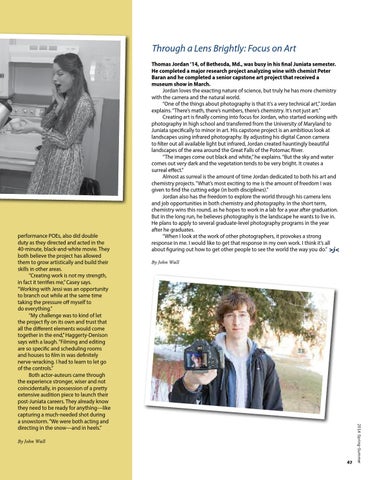Through a Lens Brightly: Focus on Art
By John Wall
By John Wall
47
2014 Spring-Summer
performance POEs, also did double duty as they directed and acted in the 40-minute, black-and-white movie. They both believe the project has allowed them to grow artistically and build their skills in other areas. “Creating work is not my strength, in fact it terrifies me,” Casey says. “Working with Jessi was an opportunity to branch out while at the same time taking the pressure off myself to do everything.” “My challenge was to kind of let the project fly on its own and trust that all the different elements would come together in the end,” Haggerty-Denison says with a laugh. “Filming and editing are so specific and scheduling rooms and houses to film in was definitely nerve-wracking. I had to learn to let go of the controls.” Both actor-auteurs came through the experience stronger, wiser and not coincidentally, in possession of a pretty extensive audition piece to launch their post-Juniata careers. They already know they need to be ready for anything—like capturing a much-needed shot during a snowstorm. “We were both acting and directing in the snow—and in heels.”
Thomas Jordan ’14, of Bethesda, Md., was busy in his final Juniata semester. He completed a major research project analyzing wine with chemist Peter Baran and he completed a senior capstone art project that received a museum show in March. Jordan loves the exacting nature of science, but truly he has more chemistry with the camera and the natural world. “One of the things about photography is that it’s a very technical art,” Jordan explains. “There’s math, there’s numbers, there’s chemistry. It’s not just art.” Creating art is finally coming into focus for Jordan, who started working with photography in high school and transferred from the University of Maryland to Juniata specifically to minor in art. His capstone project is an ambitious look at landscapes using infrared photography. By adjusting his digital Canon camera to filter out all available light but infrared, Jordan created hauntingly beautiful landscapes of the area around the Great Falls of the Potomac River. “The images come out black and white,” he explains. “But the sky and water comes out very dark and the vegetation tends to be very bright. It creates a surreal effect.” Almost as surreal is the amount of time Jordan dedicated to both his art and chemistry projects. “What’s most exciting to me is the amount of freedom I was given to find the cutting edge (in both disciplines).” Jordan also has the freedom to explore the world through his camera lens and job opportunities in both chemistry and photography. In the short term, chemistry wins this round, as he hopes to work in a lab for a year after graduation. But in the long run, he believes photography is the landscape he wants to live in. He plans to apply to several graduate-level photography programs in the year after he graduates. “When I look at the work of other photographers, it provokes a strong response in me. I would like to get that response in my own work. I think it’s all about figuring out how to get other people to see the world the way you do.” >j<
